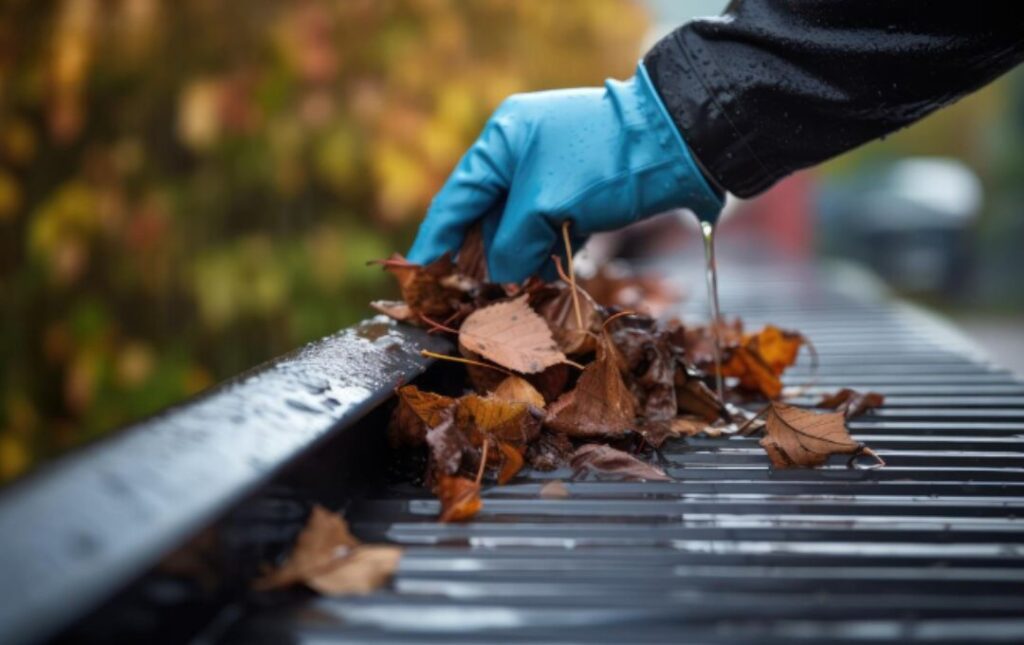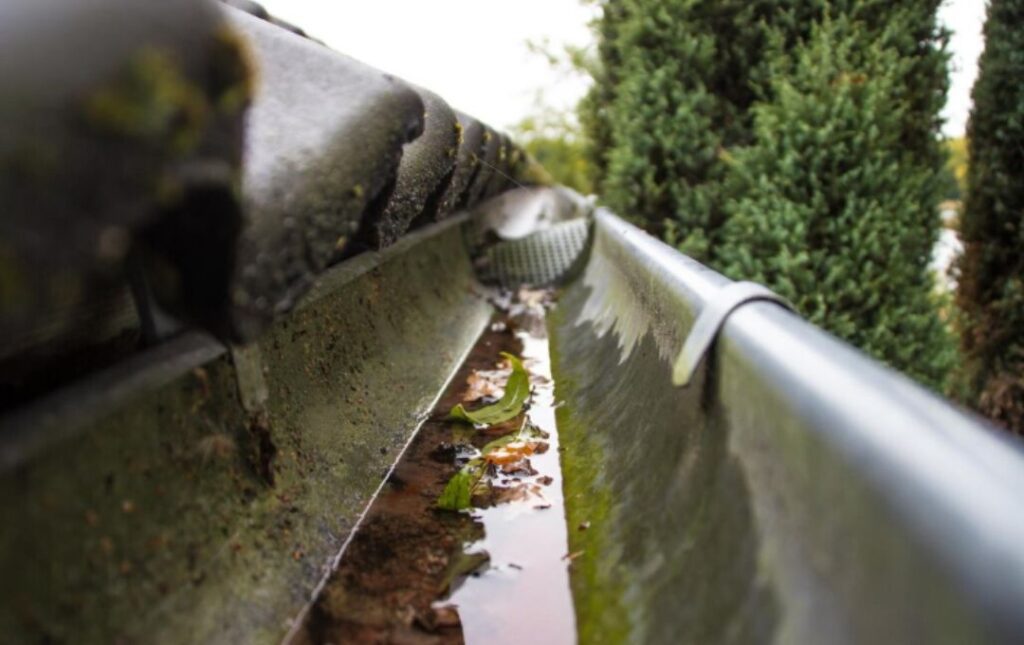
After a heavy storm, your home’s gutters are often left clogged with leaves, branches, and other debris. If not cleaned promptly, this buildup can lead to water overflow, roof damage, foundation issues, and even pest problems. Cleaning rain gutters after a storm is one of the simplest yet most important steps in post-storm home maintenance. In this quick guide, we’ll walk you through the essential tips and steps to safely and efficiently clean your gutters, protect your property, and restore proper water drainage before bigger issues arise.
Why Post-Storm Gutter Cleaning Is Crucial
After a storm, it’s easy to forget about your gutters. But those long tubes attached to your roof do a big job they move rainwater safely away from your home. When gutters get clogged with storm debris like leaves, twigs, and roof grit, the entire system can fail. That’s why post-storm gutter cleaning isn’t just a good idea it’s critical for protecting your home.
1. Prevents Roof and Foundation Damage
When gutters are blocked, rainwater overflows and pools around the base of your home. Over time, this can weaken your foundation or even cause basement flooding. On the roof, trapped water can seep under shingles, leading to rot, mold, and leaks. Quick gutter cleaning after a storm ensures proper drainage and protects both the top and bottom of your house.
Looking for a trusted Gutter Cleaning Service in Brooklyn, NY? AKT Construction NY Inc. offers professional gutter cleaning to prevent water damage and keep your home protected all year round.
2. Reduces Risk of Pest Infestation
Clogged, wet gutters make a cozy home for mosquitoes, rodents, and birds. These pests can cause health hazards and damage your roof or attic. By cleaning out debris after a storm, you remove the nesting materials and standing water that attract them.
3. Helps Spot Hidden Damage Early
Storms can crack gutters, loosen brackets, or tear downspouts. By inspecting and cleaning your gutters right after a storm, you can catch these issues before they lead to expensive repairs. A small crack today could turn into a major leak tomorrow.
4. Extends Gutter Lifespan
Just like any part of your home, gutters last longer when they’re well cared for. Storm debris is heavy and can strain or bend your gutters if left too long. Cleaning them promptly helps prevent sagging and rust, keeping your system strong for years.
Essential Tools and Safety Gear You’ll Need
Before you climb that ladder like a superhero, make sure you have the right tools:
- A strong ladder (safety first!)
- Gloves and safety glasses
- A gutter scoop or a small trowel
- A garden hose with a spray nozzle
- A bucket or tarp for the gunk
- (Optional) A gutter cleaning wand or leaf blower for long gutters
Step-by-Step Guide to Clean Rain Gutters After a Storm

Think of this like a simple recipe for protecting your home after bad weather . Rain gutters play a major role in keeping water away from your roof and foundation but after a storm, they can get clogged or damaged. Here’s how to clean them the right way:
Step 1 – Inspect the Gutter System for Damage
Start by walking around your home and visually inspecting your entire gutter system. Look for obvious signs of damage are the gutters bent, sagging, or pulling away from the roofline? Check for cracks or splits in the gutter sections. Also, don’t forget to look at the downspouts (the vertical pipes that carry water down) they can easily become disconnected or crushed by falling branches. Spotting these issues early can prevent bigger problems like leaks or water damage, and if anything looks serious, it might be time to call in a storm gutter repair expert.
Step 2 – Remove Large Debris by Hand
Now it’s time to roll up your sleeves. Put on a sturdy pair of gloves and use either your hands or a gutter scoop to remove large debris. Storms often leave behind leaves, twigs, shingle grit, and other gunk that clog up your gutters. Drop everything into a bucket, garbage bag, or lay out a tarp to collect the debris. This step might be messy, but it’s essential to clean clogged rain gutters properly.
Step 3 – Flush Gutters with Water
After the large debris is gone, use a garden hose with a spray nozzle to rinse the inside of the gutters. Start from the end farthest from the downspout and work toward it. This helps wash out the smaller dirt and reveals how well your gutters are draining. If the water isn’t flowing freely out the bottom, there could be a blockage deeper inside the downspout.
Step 4 – Check Water Flow
Now, take a close look at how the water moves. Does it go down the spout, or is it backing up and spilling over the sides? If water pools or overflows, it means there’s still a clog somewhere. You may need to detach the downspout and use a plumber’s snake or pressure nozzle to clear the blockage. Fully cleaning clogged rain gutters ensures that rainwater goes exactly where it’s supposed to—away from your home.
Step 5 – Make Basic Repairs If Needed
Once everything is clean and flowing, inspect again for small repairs. Loose screws? Tighten them. Found a tiny leak or hole? Use gutter sealant or waterproof tape for a quick fix. If you’re not sure how to repair it—or if the damage is beyond a DIY job—this is a great time to call in professionals like AKT Construction NY Inc. We specialize in fast and affordable storm gutter repair and maintenance, so you won’t have to worry about long-term water damage
When to Call a Professional Gutter Cleaner
Knowing when to call a professional gutter cleaner can save you time, money, and prevent costly home damage. Here are some key signs that it’s time to bring in the experts:
1. Severe Clogging or Blockage
If your gutters are overflowing or water is pooling around your foundation despite your efforts, the clog may be too tough or deep for DIY cleaning.
2. Frequent Overflowing During Rain
When gutters can’t keep up with rainfall, causing water to spill over the edges, it’s often a sign they need thorough cleaning and inspection.
3. Visible Damage or Sagging Gutters
If gutters are pulling away from the house, sagging, or have obvious cracks or rust, professionals can repair or replace them safely.
4. Moss, Mold, or Algae Growth
Excess moisture and debris buildup encourage mold and moss, which require specialized cleaning methods.
5. High or Hard-to-Reach Gutters
If your gutters are on a multi-story house or in tricky locations, hiring pros with proper tools and safety gear is best.
6. Regular Maintenance Schedule
Even if your gutters don’t show immediate issues, scheduling professional cleaning once or twice a year keeps your system in top shape.
Final Thoughts
Cleaning your rain gutters promptly after a storm is key to protecting your home from costly water damage and structural problems. By taking quick action to remove debris and ensure proper water flow, you help maintain the integrity of your roof, walls, and foundation. Regular gutter maintenance, especially after severe weather, not only safeguards your property but also saves you time and money in the long run. Make gutter cleaning a priority after every storm, and your home will stay safer and drier through all seasons.
